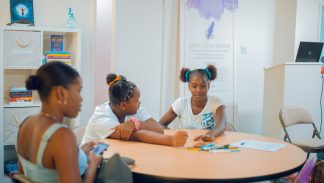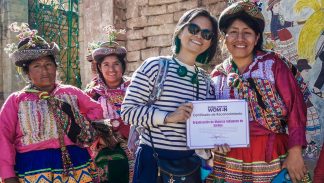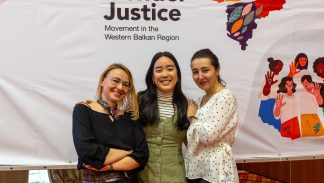COP30: The Future is Fertile, If We Fund It. Reproductive Justice in a Collapsing Climate
The climate crisis is altering the most intimate and essential aspect of human life: our choice and ability to give birth safely.
Across Africa and globally, pregnant people are navigating food insecurity, toxic air and water, droughts, displacement, and failing health systems, all made worse by climate change. These cascading crises are changing what it means to be pregnant, to give birth, and to raise a child. In just one example, the effects of climate change in Kenya — droughts, floods and lack of safe sanitation — increased rates of school dropout, transactional sex, and early pregnancy among girls.
And yet, global climate financing continues to ignore reproductive healthcare, treating it as separate, optional, or outside the scope of climate resilience. In fact, investments in the overall health sector by climate funds are close to zero. In many important ways reproductive health is especially sensitive to the health of the environment and to environmental violence. From extreme heat’s impacts on pregnant people, to exposure to toxic chemicals and microplastics, to hurricane recovery presenting challenges to accessing reproductive care, the climate crisis is a crisis for reproductive health. Climate justice and reproductive justice are linked as irrevocably as people and the environment.
If we want a livable future, we must fund the reproductive care that makes that future possible.
That’s why a delegation of Global Fund for Women-supported feminist climate leaders will be at COP30, the annual United Nations climate summit, to demand climate financing that includes sexual and reproductive health and rights.
Our partners are already developing climate-resilient birth practices, strengthening maternal health networks, and fostering community-based nutrition systems. They are advancing climate and reproductive justice solutions that are saving lives and sustaining care. Still, they are chronically under-resourced and overlooked by traditional funding models that fail to recognize their scale, impact, and urgency.
We cannot achieve climate justice without investing in reproductive justice. In fact, these are not separate fights — they are one. If global climate policy ignores reproductive justice as a central pillar of women’s rights, then these global frameworks will only serve to deepen existing gender inequalities.

The Impacts: Climate Breakdown and Reproductive Health
In Nigeria, the rainy season is no longer predictable. Sudden, heavy downpours cause flash floods that devastate entire communities. In rural areas, overflowing sewage from the flooding earlier this year contaminated drinking water. Community health workers reported a spike in early miscarriages and an increase in infections in pregnant people.
One of our partners recounted a woman giving birth during a flood. The local community clinic was submerged in water, and roads to other hospitals were impassible. A health attendant recounted: “I have never seen a situation like this. There was nothing to use in assisting her to deliver the baby… It became a problem.” The mother almost lost her life. When she finally gave birth, she immediately cradled her newborn above the rising, polluted water all around her to try to keep the tiny baby safe.
Nigeria already has the second-highest maternal mortality rate in the world. One pregnant person dies every seven minutes from childbirth. When clinics are destroyed, roads are impassable, or care is delayed due to climate-related emergencies, these deaths multiply. Climate hazards lead to worse maternal outcomes, including maternal mortality, preterm birth, stillbirth, as well as lasting mental health tolls of anxiety and depression.
And Nigeria is not alone. Research shows women are 14 times more likely than men to die during climate disasters. Exposure to extreme heat during pregnancy increases complications in pregnancy by 25% and can double the risk of miscarriage.
Climate change is worsening waterborne diseases, reducing food access, and heightening exposure to gender-based violence — all of which impact a person’s ability to decide when or whether to have children, or if they can access the care they need.
What’s Missing: A Broken Funding Model
Despite the clear connection, less than 0.2% of global climate finance goes to women-led climate initiatives of any kind. The vast majority of funding flows to emissions mitigation and adaptation infrastructure, while reproductive health remains siloed in development or global health sectors.
This separation is artificial and deadly. Without a gender and power analysis, climate funding fails to address how the climate crisis plays out in people’s bodies and lives.
What’s Working: Solutions from the Intersection of Climate and Care
At the International Center for Environmental Health and Development (ICEHD) in Nigeria, climate and reproductive justice are addressed together, at the community level. In rural areas where hospitals are miles away and skilled medical staff are often absent, thousands of women rely on one source of care: traditional birth attendants. ICEHD is helping these birth attendants deliver more effective care in a changing climate with climate crisis preparedness and health intervention strategies.
This means the birth attendants are equipped with updated medical kits, sanitation supplies and generators. They know how to identify pregnancy complications early, and in the case of the woman who held her newborn away from the floodwaters, they are prepared to provide life-saving care in climate disasters.
“By training birth attendants — the hands that catch life — we are building a safer world for mothers and babies in a changing climate,” said Ndudi Bowei of ICEHD. These locally led interventions are protecting lives in places where healthcare systems are failing under climate pressure.

And ICEHD is not alone. From Nigeria to Jamaica, Global Fund for Women partners are integrating reproductive justice and climate resilience solutions for survival and resilience across adapation and mitigation interventions.
ICEHD is part of an Africa Climate Justice Movement supported by Global Fund for Women. ICEHD and over 40 other organizations decide where Global Fund for Women support should go and what success looks like. This participatory grantmaking shifts power to movements to make their own decisions. It also serves to bring organizations together. “The collective is very powerful,” said Ndudi Bowei. This funding model gathers organizations to pool knowledge and experience for greater impact.
Our Call to Action: Fund the Front Lines
Every day, we witness how climate change intersects with food insecurity, collapsing infrastructure, health inequities, and gender-based violence. The women, girls, and gender-diverse people we work with are not just victims of this crisis, they are leaders pioneering solutions. And they are asking the global community to meet the urgency of this moment with increased funding. We echo their calls:
Stop funding in silos. Fund climate-resilient reproductive healthcare as essential infrastructure.
This means:
- Integrated funding approaches that explicitly link climate and reproductive health, including joint funding and research streams and multilateral efforts that bridge climate and health sectors.
- Grassroots first: direct funding to local organizations led by women, girls, and marginalized communities who are already responding with care and innovation.
- Feminist leadership in climate decision-making to amplify the voices and solutions of impacted communities.
Global Fund for Women funds grassroots climate justice organizations working in reproductive health and beyond with no-strings-attached funding to lead solutions in their communities. This includes ICEHD’s life-saving care for pregnant people in Nigeria. This kind of grassroots-first funding is rare, but it shouldn’t be.
Feminist climate justice is already in motion. We see it all around us. Now it’s time to fund it with urgency and scale. Women and girls around the globe can’t wait.
Created in collaboration with Ndudi Bowei of ICEHD.


